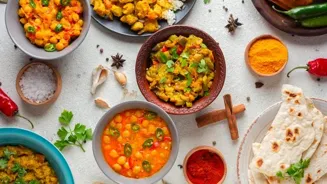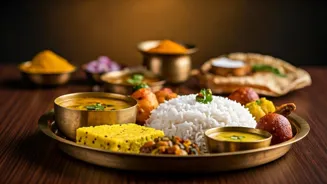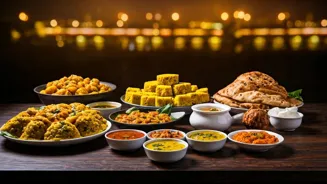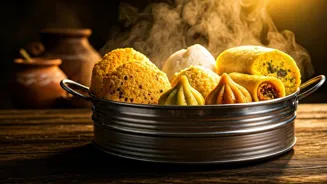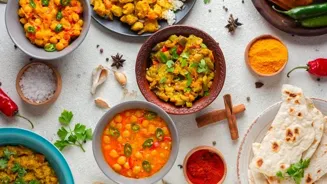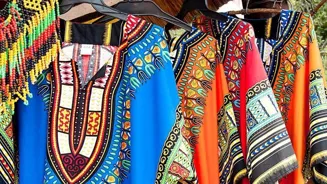Dive into India's regional cuisines with 8 unique dishes! Explore the culinary tapestry of India through flavorful vegetarian delights. From Dum Aloo in Kashmir to Chak-hao Kheer in Manipur, each dish tells
a story of tradition and creativity. Discover the hidden gems of Indian cuisine and tantalize your taste buds with a diverse array of flavors. Embark on a delicious
Namaste and welcome, food lovers! India, a land of diverse cultures and landscapes, boasts a culinary tapestry as vibrant and varied as its people.
Forget your usual daal-roti; we're diving deep into the heart of regional Indian cuisine, uncovering hidden gems and showcasing eight unique vegetarian dishes that will make your taste buds sing.
This culinary journey will transport you from the snow-capped Himalayas to the sun-kissed beaches, all within the comfort of your imagination (for now, at least!). Get ready to discover flavours you never knew existed and appreciate the incredible culinary heritage of India.
So, grab a seat, loosen your belts, and let's begin this delicious adventure! Prepare to be amazed by the sheer variety and ingenuity on display, a testament to the resourcefulness and creativity of Indian cooks across generations.
Each dish tells a story, reflecting the local ingredients, climate, and cultural traditions of its region.
Slow-cooked Dum Aloo in Kashmiri spices, a culinary delight
Our first stop takes us to the northern state of Jammu and Kashmir, where we encounter Dum Aloo. This isn't your average potato curry!
Small, baby potatoes are slow-cooked in a rich and fragrant gravy, infused with spices like ginger, fennel, and Kashmiri chilli (don't worry, it's more flavour than fire!).
The potatoes are often deep-fried before being simmered, giving them a lovely crisp exterior and a soft, melt-in-your-mouth interior. The gravy itself is a masterpiece, a symphony of spices that creates a warm and comforting flavour profile.
Dum Aloo is typically served with rice or roti, making it a hearty and satisfying meal, perfect for the chilly Kashmiri weather. The dish is a staple during festivals and celebrations, showcasing the culinary pride of the region.
While many variations exist, the essence remains the same: slow-cooked potatoes in a flavourful, aromatic gravy. It’s a dish that truly warms the soul, and a must-try for anyone exploring Kashmiri cuisine.
Bengali dish Aloo Posto showcases elegance of poppy seeds
Next, we travel east to the vibrant state of West Bengal, home to the iconic Aloo Posto. This simple yet elegant dish features potatoes cooked in a creamy poppy seed paste.
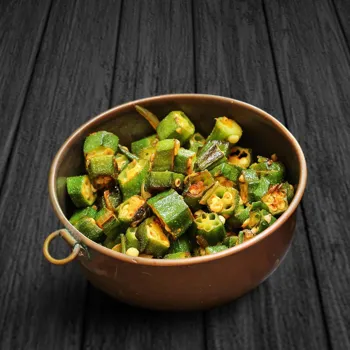
Posto, or poppy seeds, are a common ingredient in Bengali cuisine, lending a subtle nutty flavour and a luxurious texture to the dish. The potatoes are usually cubed and simmered in a mixture of poppy seed paste, green chillies, and turmeric.
The simplicity of the ingredients allows the flavour of the poppy seeds to shine through, creating a dish that is both comforting and refined. Aloo Posto is typically eaten with rice and is a popular lunchtime staple in Bengali households.
Interestingly, poppy seeds have a cooling effect on the body, making this dish particularly popular during the hot summer months. It’s a testament to the Bengali appreciation for understated elegance and the ability to create magic with minimal ingredients.
Avial: Kerala's iconic mixed vegetable dish, rich in tradition, flavors, and nutrients
Moving south, we arrive in the coastal state of Kerala, where we discover Avial. This mixed vegetable dish is a celebration of fresh, seasonal produce.
A medley of vegetables like drumsticks, carrots, beans, potatoes, snake gourd, and raw bananas are cooked in a coconut-based gravy, seasoned with curry leaves and coconut oil. Avial is lightly spiced, allowing the natural flavours of the vegetables to take centre stage.
What sets it apart is the addition of curd, which adds a tangy and refreshing note to the dish. Avial is a traditional dish served during Onam, the harvest festival of Kerala, and is an integral part of the Onam Sadhya, a grand vegetarian feast.
The dish is not only delicious but also incredibly nutritious, packed with vitamins and minerals from the variety of vegetables used. Avial perfectly captures the essence of Kerala cuisine: fresh, flavourful, and rooted in tradition.
It’s a vibrant and wholesome dish that reflects the abundance of the state’s natural resources.
Exploring Gujarat's traditional dish Undhiyu, slow-cooked in earthen pots for a smoky winter delight
Our journey continues to the western state of Gujarat, where we encounter Undhiyu. This one-pot casserole is traditionally cooked upside down in earthen pots, buried in the ground and slow-cooked over a fire, giving it a unique smoky flavour.
Undhiyu is a winter specialty, made with a variety of seasonal vegetables like green beans, brinjals, potatoes, sweet potatoes, and muthia (steamed dumplings made from chickpea flour). The vegetables are mixed with a blend of spices, stuffed with a green masala paste, and slow-cooked until tender.
The process of cooking Undhiyu is a communal affair, with families and communities coming together to prepare this festive dish. While the traditional method of cooking Undhiyu is time-consuming, the results are well worth the effort.
The smoky flavour, combined with the sweetness of the vegetables and the spiciness of the masala, creates a truly unforgettable culinary experience. Undhiyu is a dish that embodies the spirit of Gujarat: vibrant, flavorful, and deeply rooted in tradition.
Rajasthani Gatte ki Sabzi: Gram flour dumplings in tangy yoghurt gravy
Next, we venture to the desert state of Rajasthan, where we find Gatte ki Sabzi. This dish features gatte (gram flour dumplings) simmered in a tangy and spicy yoghurt-based gravy.
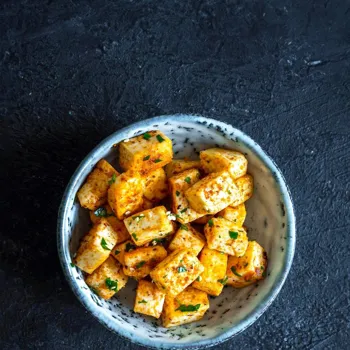
The gatte are made from gram flour, seasoned with spices like turmeric, chilli powder, and cumin, and then steamed or boiled before being added to the gravy. The gravy itself is a flavorful blend of yoghurt, onions, tomatoes, and spices.
Gatte ki Sabzi is a staple in Rajasthani cuisine, particularly in areas where fresh vegetables are scarce. The dish is hearty and filling, providing much-needed sustenance in the arid climate. What's remarkable is the ingenuity of using gram flour to create a delicious and nutritious dish.
It showcases the resourcefulness of Rajasthani cooks in making the most of limited ingredients. Gatte ki Sabzi is typically served with roti or rice and is a testament to the resilience and culinary creativity of the people of Rajasthan.
Discover Manipur's Chak-hao Kheer, a unique dessert made with black rice, milk, sugar, and cardamom
Our final culinary stop takes us to the northeastern state of Manipur, where we discover Chak-hao Kheer. This unique dessert is made from black rice (Chak-hao), milk, sugar, and cardamom. Chak-hao is a special type of rice with a distinctive nutty flavour and a beautiful purplish-black hue.
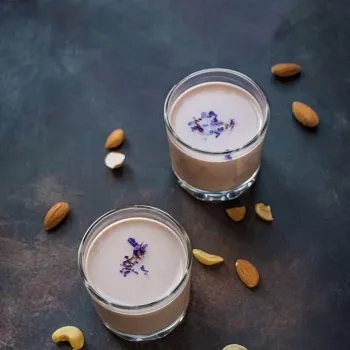
The rice is slow-cooked in milk until it becomes soft and creamy, and then sweetened with sugar and flavoured with cardamom. Chak-hao Kheer is a traditional dessert served during festivals and special occasions in Manipur.
The black rice not only adds a unique flavour to the kheer but also boasts numerous health benefits, being rich in antioxidants and nutrients. The dessert is not overly sweet, allowing the natural flavour of the black rice to shine through.
Chak-hao Kheer is a perfect example of the understated elegance of Manipuri cuisine. It’s a simple yet delicious dessert that showcases the region’s unique culinary heritage and its connection to the land. It is a delightful and nutritious way to end our culinary journey across India.
